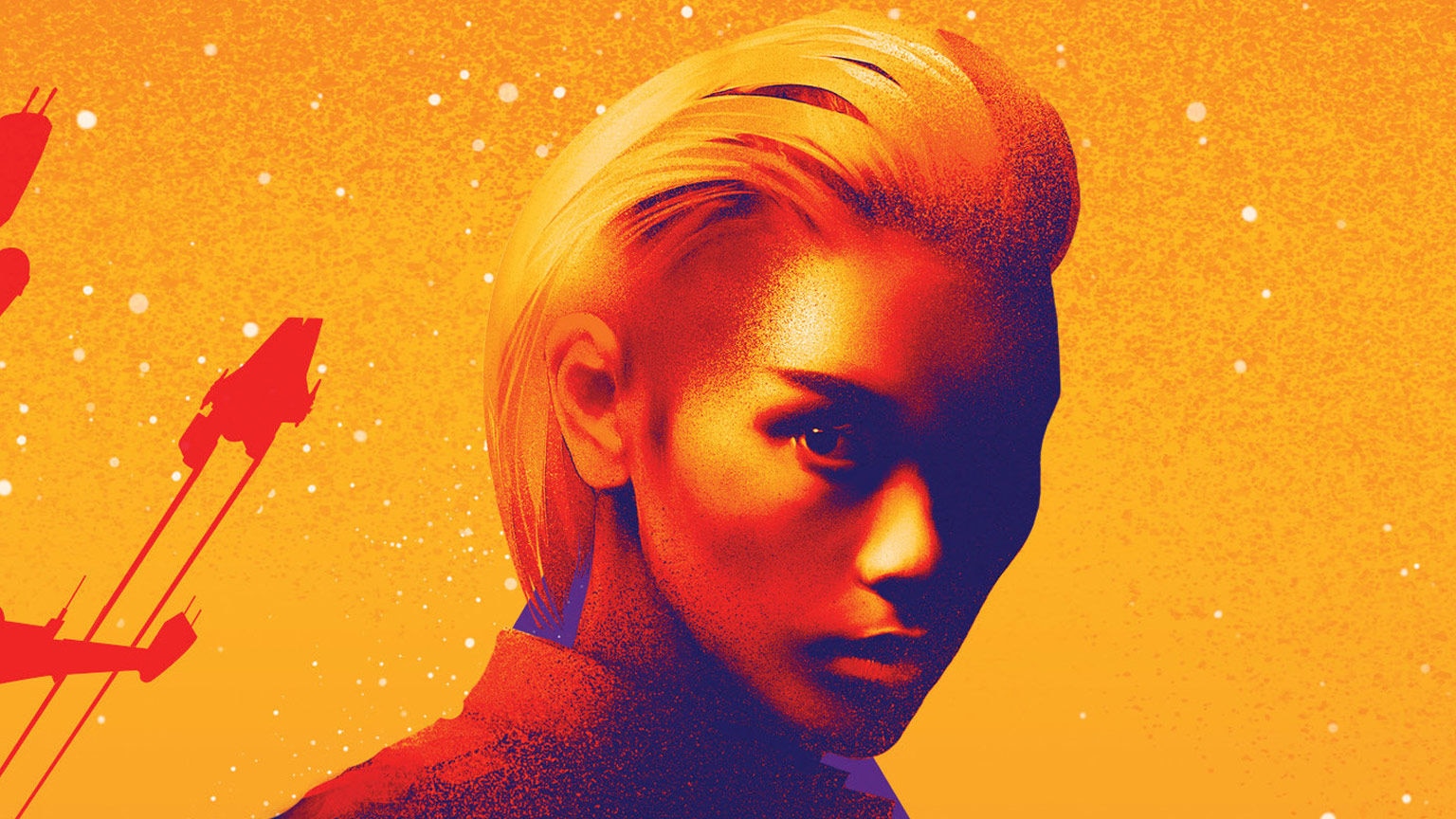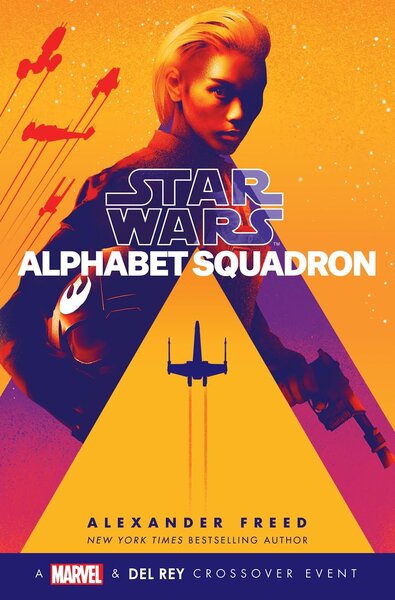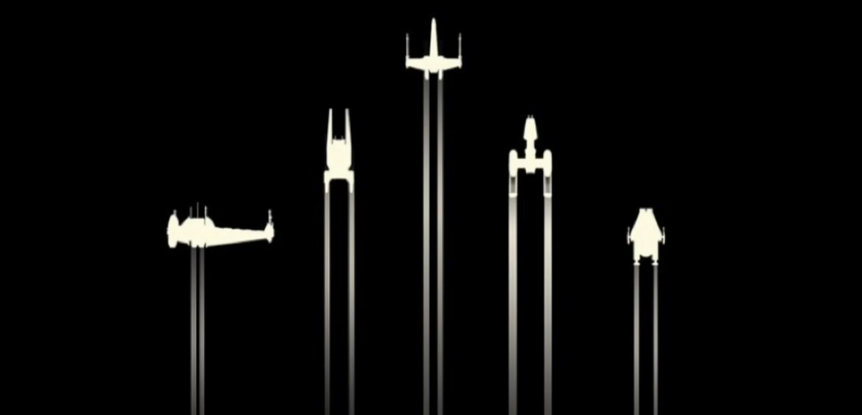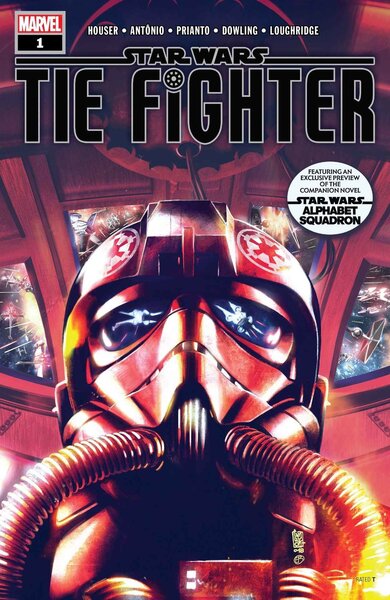Create a free profile to get unlimited access to exclusive videos, sweepstakes, and more!
A galaxy's worth of new canon introduced in the book Star Wars: Alphabet Squadron

Some pilots in the Star Wars movies get a decent amount of their stories told. You get to know Wedge Antilles a little bit in the films (you always feel good when you see him), and he had his story fleshed out further in the novels. Poe Dameron, of course, is a major player in the new movies. Other pilots, however, pop in for a line here and there and then are either blown up or never seen again. What are their stories? Surely they have them.
The latest book that takes place in the galaxy far, far away, titled Star Wars: Alphabet Squadron, is all about pilots and the stories they have to tell. Written by Alexander Freed (Star Wars: Battlefront: Twilight Company, the novelization of Rogue One), the new in-canon novel takes place in the period following Star Wars: Return of the Jedi. The Empire is in shambles, and the New Republic is just being born.
There's a great deal of new canon introduced in the book, as well as some expanded canon for one particular character that we already know and love. What new morsels of lore does Alphabet Squadron bring to the Dejarik board? I'm here to tell you. To paraphrase a recurring line from the book, this is the story it tells.
**WARNING: From this point on there will be massive spoilers for the book Star Wars: Alphabet Squadron. That's the entire point of this article. If you are at all interested in the story of this book, then you should definitely read it before reading any of this.**
GALAXY IN CHAOS (TOO MUCH CONFUSION, I CAN'T GET NO RELIEF)
Probably the most important question to ask regarding any new piece of the Star Wars saga these days is this: when in the karkin' kriff does it take place? I've already said that it takes place after Star Wars: Return of the Jedi, but in the scope of the new expanded canon, that doesn't really help.
In terms of the timeline, the book's story takes place after the rebels have won the Battle of Endor, as well as after Operation Cinder, which is depicted in the comic Star Wars: Shattered Empire and Star Wars: Battlefront II. That particular operation is a very important plot point in this story; to sum it up at light speed, Operation Cinder was a particularly nasty bit of pre-planning done by the Emperor that would go into effect in the event of his death. When that unexpectedly happened, the operation began — red-caped droids that bore faces with his lovely holographic likeness were sent out to key Imperial players, and their orders were to completely wipe out a bunch of very important (and very populated) worlds.
Why? Some of the characters in this book ask themselves that very same question. The answer? Emperor Palpatine was a spiteful, shifty, wrinkled old d**k.
We're post-Cinder, but we're also slightly before the events of Chuck Wendig's Aftermath book trilogy. The galaxy is in total chaos. The "New Republic" has been formed out of the old Rebel Alliance, but as many of their members will tell you, they didn't expect to win. They're used to running and hiding, not governing and leading. They aren't used to be being on the offensive, and they are not as united in their common goals as they once were.
There's no singular Death Star to focus an attack on (though everyone worries/expects that another one lurks somewhere, half-built), and they now have to comb through the galaxy, using intelligence, taking out Imperial remnants bit by bit. The New Republic barely has its own identity, aside from Chancellor Mon Mothma (briefly getting a mention) wanting to de-militarize.
It's not the time for that, because we're nowhere close to the Battle of Jakku (the Empire's final and utter defeat), and the Imps are still limping along. The death of Palpatine has left a giant void, however, and nobody in the Imperial ranks knows what to do. The chain of command is shattered, nobody knows who's in charge, and most of the higher-ups start taking control of what territory they can while they have the chance. Moff Pandion (from Wendig's first Aftermath book) gets a mention, as does Governor Adelhard, who is pulling this routine in the Anoat Sector (depicted in the short-lived mobile game, Star Wars: Uprising).
Caught in the middle of all of this are civilians, pirates, and crime syndicates. Most of the latter try to play nice with the New Republic, trying to hold on to what power they have. As usual, the civilians and innocents of the galaxy are constantly caught in the crossfire.
IMPERIAL DEFECTION
One major factor that is not helping the remnants of the Empire is an incredible spike in members defecting from their ranks. Though many Imperials did this after the destruction of Alderaan, many more did so after Endor. Any Imperials with any conscience to speak of defected during (or after) Operation Cinder, an event that clearly had no tactical point, unless you consider petty cruelty to be a tactical point. One of the pilots that defected during this time is our lead character, Yrica Quell.
She's put through her paces by Caern Adan of New Republic Intelligence, who wants her help in taking down her former colleagues in a squadron known as "Shadow Wing." Quell is one of many former Imperial assets that the New Republic adopts; they take fuel, ships, and captured droids, as well. Quell's "therapist" is actually a reprogrammed "torture droid," one of the floating black balls from the very first Star Wars film. IT-O ends up being one of the more enjoyable characters in the book.
Quell is an Imperial through and through, but now has to adapt to the Alliance (or New Republic) way of doing things. She's harboring secrets, too, but good luck cracking her exterior. Her story, in general, is one of learning to be as clever as a Rebel, yet still as ruthless as an Imperial.
She's a fascinating character who constantly questions her own moral code. She's a bit similar to Iden Versio from Star Wars: Battlefront II, but differs from her because in too many instances to count you feel that Quell really, truly, hates herself. She needs to hug a Wookiee, and fast.
WE'VE GOT LETTERS
Quell ends up as the commander of the fighter squadron for which the book is named, and they get that somewhat derisive name because all of the pilots within the group fly a different class of ship. While the Shadow Wing (and the Imperial remnant in general) uniformly uses TIE Fighters flying in total sync, this squad ends up being a collection of ships (and pilots) that were never really meant to fly together.
You've got Wyl Lark flying an A-Wing, and he's been wanting out of this war for a long time, yearning to return to the hippie planet Polyneus. There's Chass Na Chadic (a Theelin) in a B-Wing, and she's got major bantha beef with Lark after the rest of their former squadmates get dusted. Quell ends up in an X-Wing, which she gradually comes to appreciate (especially the droid it comes with), and the requisite scoundrel of the book, Nath Tensent, flies a modified Y-Wing. The most mysterious character, Kairos, flies a U-Wing transport. She spends the book bundled in rags with her face covered with a visor, and only speaks once. She's truly too cool for space school and I'm desperate to know what her deal is.
The Empire valued squadrons, but the New Republic respects pilots. This is something that Quell has to adapt to (each of her pilots have very different personalities), and it takes a while. Though they started as a ragtag joke of a group (someone dumped a whole alphabet of ships in our hangar!), Alphabet Squadron becomes a family by the end. Possible love triangle alert: Wyl, Chass, and Kairos. Here for it.
GRANDMOTHER (I HEAR SHE HATES THAT NICKNAME)
One big aspect of this book is that it ties in directly with one of Marvel Comics' new titles. The Star Wars: Tie Fighter comic series depicts the efforts of Shadow Wing before the events of the book, and it sheds a little light on the target that Adan and New Republic Intelligence is after. Their leader is Colonel Shakara Nuress, and she's still leading them in this book. She's been given the unfortunate nickname of "Grandmother," which she hates. She also sees no difference between Separatists, Rebels, or New Republic soldiers. They're all just anarchists to her.
Having the antagonist of your Star Wars story be an older woman is not common, and if Nuress is what happens when you take that leap, then they should do it more often. She's just as fascinating as Quell is, but unlike Quell, she is a true believer. She's an Imperial that is on the level of a Wilhuff Tarkin or a Grand Admiral Thrawn, and therefore she is someone that the Imps here desperately need. Operation Cinder didn't sway her opinions on anything — quite the contrary. She still talks to the red-caped droid that bore the Emperor's message to her, though it never says anything.
Grandmother (sorry, Colonel) is willing to do whatever it takes to bring the disparate factions of the Empire in line, because that is the only way the galaxy makes sense to her. The book makes this clear with the line, "She would take the role of bureaucrat and charismatic leader and mass murderer if that was what victory demanded." Sorry Grandmother, there's only one Sheev Palpatine, and he's dead. If you're in this article this deep, then you won't mind this major spoiler: Grandmother's dead by the end of the book, and the big bad wolf has nothing to do with it. She gets shot.
A REBEL RETURNS
The best treat that this book has to offer is also its strongest connection to existing canon. Alphabet Squadron is overseen by (and uses the resources of) none other than General Hera Syndulla from Star Wars Rebels. She's now a legendary war hero about five times over, and she gets the respect that she deserves from everyone. Damn right!
There are some lovely moments where Hera finds herself missing her old family, and this will bring a tear to the eye of any Rebels fan. She deals with this longing by teaching Quell how to build a family with her squadron, and even slyly sends them on a mission to an equipment cache that is located within a hidden Jedi Temple. The entire mission is really a team-building exercise in disguise, and it works. Her best piece of wisdom to Quell is, "Do they know you'll fight for them?" It's a lesson that Quell takes to heart. By the book's end, they know. They kind of know. I hope they know.
Hera Syndulla is a General that no enemy would want to face and that no subordinate would want to piss off — still, she's the powerful, beating heart of the story, and her presence made me miss Rebels to an insane degree. I love Hera. I said it. Little Jacen does not make a cameo.
DOK ONDAR'S REFERENCE DEPOT
Aside from the references to existing canon that I've already mentioned, there are so very many more within this book's pages. When Operation Cinder is talked about, the planets Naboo and Vardos both get a shout out as having averted (somewhat averted, in the latter case) the destruction. The Pyke Syndicate and Crimson Dawn get a shout. Coruscant is mentioned, and we learn that the planet is still under complete Imperial lockdown. When are they gonna liberate that great ball of city? Maybe in Alphabet Squadron III: Tokyo Drift.
Further references include Vult Skerris, Baron Rudor, and Skystrike Academy (all from Rebels), Rae Sloane (Aftermath again), podracing on Cantonica, and the inconsistency of Jedi history, which has some doubting whether those "mystics" ever existed at all. Leia Organa is mentioned in terms of her appearing in "rebel propaganda," uttering the line, "the galaxy is not afraid." Jyn Erso (Rogue One) is a hero to Chass, to the point where Chass has developed suicidal tendencies because she wants to make the same kind of difference that Jyn did. There's also a moment featuring Hera talking with Chass about the B-Wing, complete with Hera saying that she was the one who flew the first prototype — we saw that exact moment in Rebels.
There are, as always, references to things that we've never heard of, but instantly spark the imagination of the reader all the same. A fine example of this is a one-and-done mention of something called the "Bazaar of Esoteric Obscenities."
LONG SHADOWS
The book also gives us some hints as to the future of the saga. The biggest and most obvious is that this is not the last adventure that Alphabet Squadron will have — they all survive the book, and they are in good standing with the New Republic. Shadow
Wing also survived (mostly), and a mysterious figure known only as "Devon" for most of the book turns out, in the end, to be Quell's presumed dead mentor. He may have helped her defect, but we gradually see his patience with survival in the New Republic go out the airlock.
Major Soran Keize is very much alive, he knows about Grandmother's death, and he is going to get Shadow Wing back on track. There will be two more books featuring these characters, so a Quell/Keize showdown is definitely in the sabacc deck.
I might be reading into things too much, but I also caught what could potentially be a bit of a hint in terms of the final film in the Skywalker saga, Star Wars: The Rise of Skywalker. While in the magical ambiance of the Jedi Temple, basking in the majesty of "the galaxy as it is," the always-silent Kairos turns to Wyl Lark and says, "The Emperor's shadow is long."
Since so much of this book is dealing with the void suddenly left by the man who ruled over everything for 20 plus years (as well as the fallout of Operation Cinder), it was likely a reference to that. Still, it's the one moment where the mysterious Kairos actually talks, and it's in the middle of a Jedi Temple. I instantly thought of the Emperor's cackle at the end of the first trailer for the upcoming film as well as his expected comeback, and I wondered if the book was actually planting a thematic seed for his return. If anyone in this book would be able to call that 30 years ahead of time, it's Kairos.
Every pilot has a story in the galaxy far, far away, and the pilots of Alphabet Squadron have fascinating ones. If you want to experience them for yourselves, Star Wars: Alphabet Squadron is on shelves right now.





























